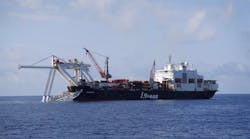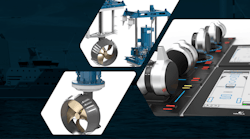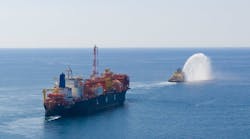John White, Hannah Longley - Baker Botts (UK) LLP
Small stranded offshore gas fields have been considered uneconomic due to geographic limitations such as distance from shore and deepwater. Monetization of such fields traditionally involves a costly fixed pipeline to a land based liquefaction plant or third party owned transportation and processing infrastructure.
Placing floating liquefied natural gas (FLNG) facilities directly over such offshore gas fields has the potential to offer a commercially attractive and environmentally sensitive approach to unlock significant stranded natural gas reserves. FLNG also offers a solution for oil fields with significant associated gas which would otherwise require re-injection into the reservoir (impacting optimum recovery of reserves), or flaring (raising environmental concerns), or gas fields in remote onshore locations near a coastline.
FLNG technology has not yet been implemented commercially.
Primary challenges
Inherent project risks such as reservoir risk, performance risk, counterparty risk, LNG market risk, and other downstream risks relating to regasification, storage, transportation, and marketing of natural gas exist. FLNG projects may be structured several ways with a range of contracts to allow the participants to allocate project risk, align interests, and maximize value.
FLNG involves the production of LNG directly at an offshore field using an FPSO type vessel. While FLNG presents new technical issues, there are many common issues between oil FPSOs and FLNGs. Parallels include hull design, mooring systems, tank sloshing, marinization of equipment, ship-to-ship transfers of liquids, and maintenance in offshore conditions. The LNG industry may further draw upon the oil industry’s experience with FPSOs by analyzing operational parallels in similar environments and comparable legal structures.
Conventional LNG projects have an essential interdependency between each component of the value chain, from gas production, liquefaction, and storage to LNG shipping, LNG regasification, and storage and gas marketing. Although each participant may have a discrete set of objectives, alignment of operational activities, financial incentives, and legal responsibilities are key to project success.
FLNG projects likely follow the conventional value chain model but may have a different business model, particularly for small stranded gas fields. An FLNG may develop small pockets of reserves (1 to 3 tcf), then redeploy elsewhere once the gas is depleted. The concept of “design one, build many” is a strategy for construction cost efficiencies. In practice, cost efficiencies need to balance the technical requirements for specific field use and operational costs. However, by de-linking the facilities from exploitation opportunities, a conventional approach to the appraisal of recoverable reserves may not be necessary, and upstream participants could find themselves managing a global fleet of FLNG vessels.
Technical issues
While FLNG technology is not yet been implemented successfully on a commercial scale, FLNG technology appears to be within reach.
Topsides: The topsides involve the integration of processing equipment with the use of major liquefaction technologies adapted to a FLNG vessel. Dry gas processing is more straight forward than wet gas (requiring separation of natural gas liquids). The feed gas process design should be as flexible as possible but depending upon the extent of upstream processing must accommodate the specific field processing requirements. Participants should select an optimum refrigeration process and an appropriate containment system, considering the constantly changing volumes within the tanks and related sloshing issues, to find the best fit for the FLNG project. Successful marinization, reliability, availability of topside design, and processes and strategies to minimize maintenance and to reduce downtime are key to improved FLNG economics.
Hull: Design and integration of the topside processing equipment with the hull relies on a deck layout that meets all operational and safety requirements for optimum performance. A number of hull sizing alternatives are available. Shipyard capability and availability combined with cost and efficiency will impact selection.
Mooring and offloading: Mooring and offloading present more technical challenge than the mooring of LNG carriers and ship-to-ship offloading of LNG, particularly in dynamic conditions. Evaluation of side-by-side and other mooring alternatives together with techniques such as the use of cryogenic hoses and piping to conduct offshore LNG transfer on FLNG scale are being developed to ensure safety and reliability.
Operational issues
The primary operational objective is safe and efficient production and supply of LNG to meet all contractual and legal obligations at minimum cost. A good relationship with local and national governments in a stable political environment helps ensure success.
Technology: Participants must address technology issues and design gaps to mitigate risks associated with new developments and technology including containment, offloading and reliability, and availability risks. Detailed policies, guidelines and strategies are vital to successful FLNG project implementation. Safety is paramount.
Logistics: Key challenges likely include remote location with limited support infrastructure. Logistical issues may include the supply, delivery, and storage of equipment and materials, provision of tug services, and regular offshore maintenance (i.e. without dry-docking). A nearby support base, whether onshore or offshore, and transfer of crew, whether by boat or to a nearby base by plane or helicopter, impacts staffing for vessel operation.
Scheduling: Optimizing the schedule of gas receipt, processing, and liquefaction to meet LNG delivery obligations, and the scheduling of LNG tanker arrivals and liquid cargo transfers relies on a willingness by all players to manage and to share operational risk. Issues such as reduced gas to send-out ratio, storage capacity, berthing capability and late arrival of LNG vessels may result in significant liabilities (i.e. operational failure at any stage of the process may cause contracted delivery obligations to be breached, a shut-down of the FLNG vessel, and a shut-in of the field).
Commercial issues
The economic viability of an FLNG project for a small stranded offshore gas field depends on a range of factors such as availability and price of more accessible gas and other fuels (such as oil), cost of developing and operating upstream assets for an integrated project, cost of procuring and operating an FLNG vessel, demand, and market price for LNG.
FLNG projects have a shorter build period (an estimated three years) compared with conventional onshore LNG projects. This means small stranded gas fields may capitalize on the advantages of a fast track development. In addition, recent project cost comparisons indicate that FLNG project costs may be in the region of $550 to $700 per metric ton of annual capacity versus $1,200 to $1,500 for current onshore projects.
The commercial feasibility of an FLNG project relies heavily upon a detailed analysis of the risks such as use of new technology, reservoir performance, contractual terms for gas sales and LNG sales, project delivery, the legal framework, and the regulatory and political environment.
Legal issues
To successfully develop stranded gas resources, responsibility and legal risk for each operation in the FLNG process must be properly allocated on a sustainable basis.
Potential project structures: Under an integrated model, the upstream participants’ share of production is set out in the respective granting instrument (i.e. the production sharing contract or license and, as between the parties, the joint operating agreement) and the upstream participants build all necessary infrastructure to produce, liquefy, and market the natural gas. In the context of FLNG, the upstream legal regime, applicable fiscal terms, and local laws likely impact the choice of structure. It is possible that the costs to acquire and operate a FLNG vessel will be recoverable under the terms of the granting instrument, but may result in potential rights of the State or third parties to the project infrastructure. Key issues include ownership of the gas, its quality specification, its processing requirements, whether or not the gas reserves will be dedicated to the FLNG project, and where title to the gas will pass. There may be specific requirements including terms and pricing for marketing and supply of LNG to the local market.
In a project company model, the project company that owns the liquefaction facility purchases feed gas from the upstream participants, processes and liquefies the gas into LNG, and sells the LNG to buyers for its own account. This provides flexibility for upstream participants, contractors, and buyers to take an equity interest in the project company.
Under a tolling model, the owner/operator of the liquefaction facility does not take title to the gas or LNG as it is processed, liquefied, and stored. Instead, the tolling company receives a fee for providing the tolling services. Tolling arrangements may be beneficial where the upstream participants prefer not to take FLNG construction and operating risk.
Construction and operation
Typical construction risks such as delivery on time and within budget and compliance with all contractual and class requirements in accordance with the design and performance criteria apply. Ideally the purchaser will seek a performance “wrap” from the primary contractor, either by entering into a single construction contract or by having two separate contracts for the hull and the topsides with an additional umbrella contract allocating primary responsibility for overall FLNG vessel performance.
Extensive commissioning may be required due to the implementation of new technology and integration issues. Likely an engineering, procurement, construction, integration, and commissioning (EPCIC) contract will be agreed to ensure performance obligations are met over an agreed commissioning period. An operations contract also may be required to ensure the safe, efficient performance of the FLNG vessel over a longer period of time, together with detailed provisions for operational handover and a technology license for ongoing operations.
The FLNG vessel may be chartered as opposed to owned which typically means that the owner will bear operational and performance risk in return for a “hire” payment. Charter terms need to be aligned with the construction contract regarding delivery and performance, in particular, the gas receiving capacity, production and send-out rates, fuel consumption, and ship-to-ship offloading capability (in addition to typical LNG vessel performance requirements).
Contractual structure
Value chain interfaces demand that material legal provisions and key terms be aligned across the suite of project agreements (including contract duration, force majeure relief, and termination rights) to ensure the rights and obligations are allocated to mitigate risk and to align participants’ interests. Robust contracts addressing project specific issues are key to ensuring that risks are managed appropriately and effectively.
Conclusion
FLNG presents an opportunity to develop stranded gas reserves. Due to the challenges of implementing new technology, the first FLNG project is likely to occur somewhere with favorable sea conditions and a stable fiscal and political environment. Market supplies of LNG combined with the economic downturn could slow progress of FLNG projects in the short term. Banks may be less willing to finance riskier projects and buyers may prefer more conventional projects as they seek security of supply.
However, the number of planned FLNG projects and related spending is expected to increase as rising energy demand encourages companies to develop smaller gas reserves in areas that are more remote. Provided development, implementation, operation, and legal challenges are managed successfully, FLNG might offer a fast-track, flexible, and cheaper alternative than conventional onshore LNG terminal.




